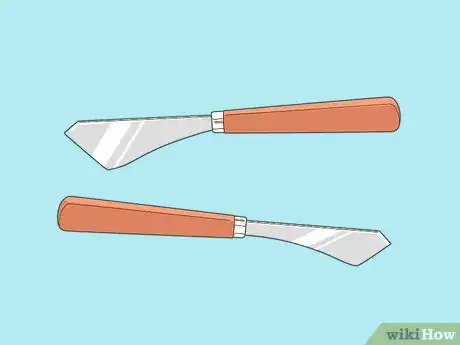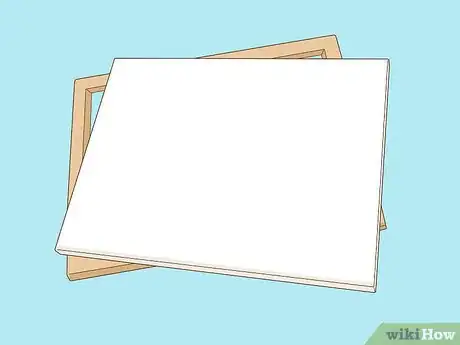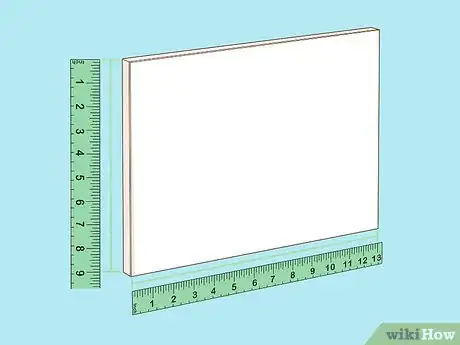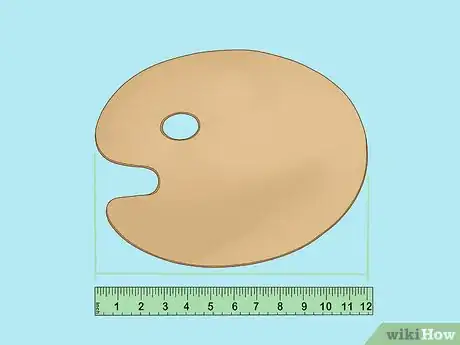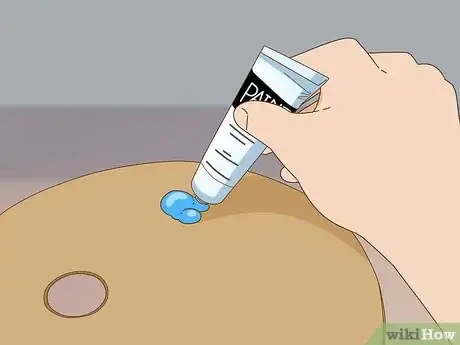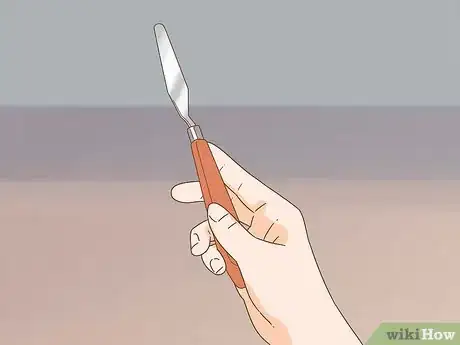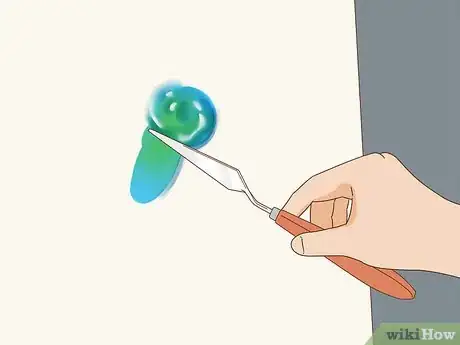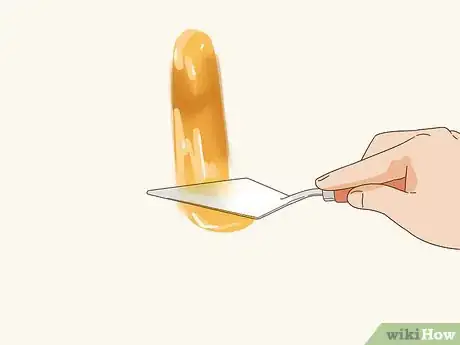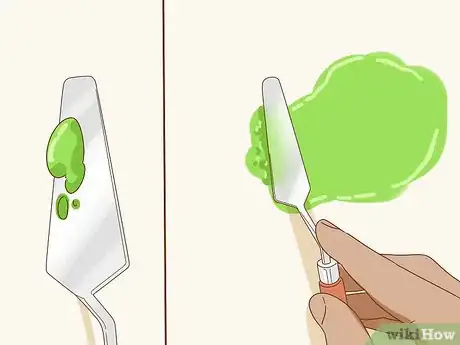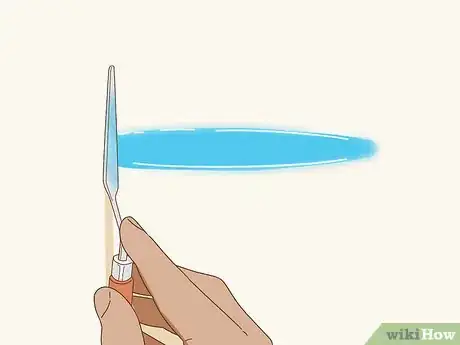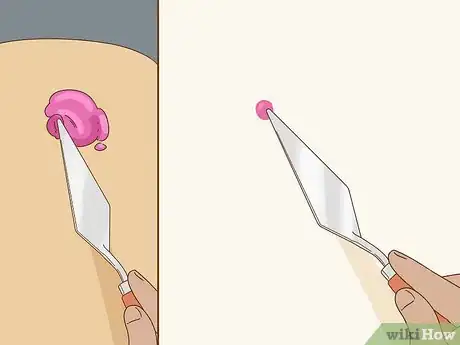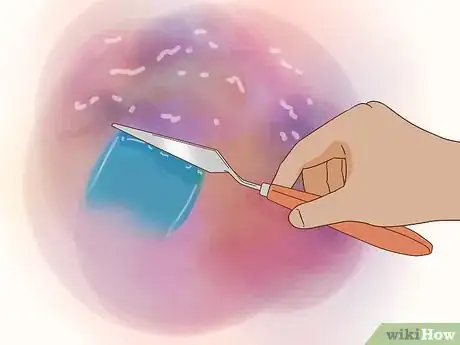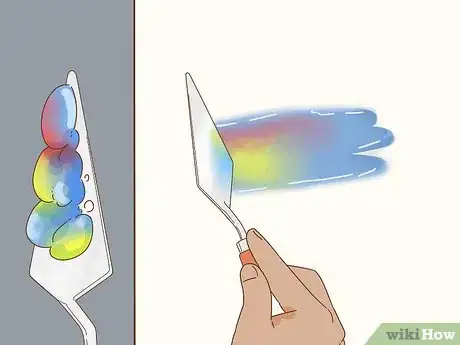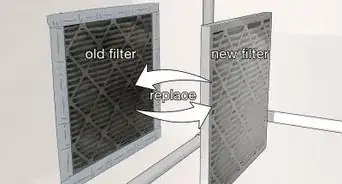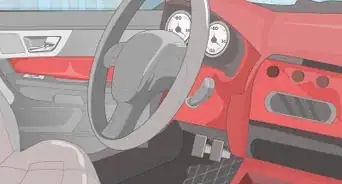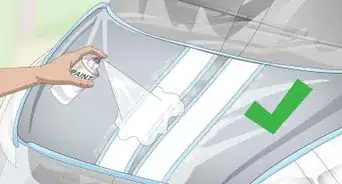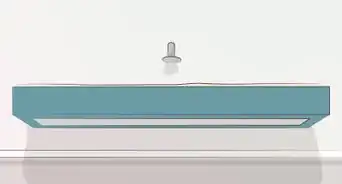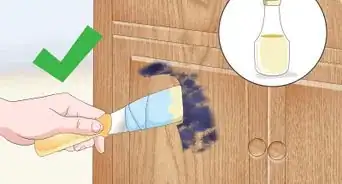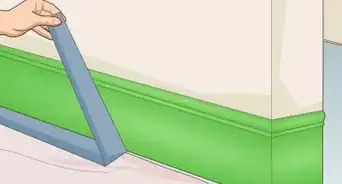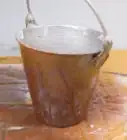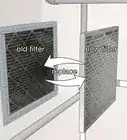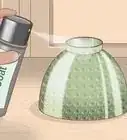This article was co-authored by Antoine de Villiers. Antoine de Villiers is an Artist and the Founder of Antoine Art Studio LLC based in Savannah, GA. Antoine has over 25 years of experience, specializing in oil painting, graphite & charcoal drawing. She has had over 70 exhibitions around the globe and her work has received numerous awards including Best Figurative Artist by The Richmond Art Museum, Indiana (USA), Best Solo Artist by Eric Smith at the New York Art Expo, and first place in Figurative Painting by Pamela Jean Tinnen from Artrepreneur. She earned her Web Design Diploma from Boston Business College and studied Indian Art, Visual Art, and Modern Art at the University of Oxford, Department of Continuing Education.
This article has been viewed 32,297 times.
Palette knives, also known as painting knives, have been favored by some of the greatest artists in history. Whether used with oil paints or acrylics, the blunt blades of these tapered tools can produce a variety of effects. With different angles and pressure levels, you can use a palette knife to build up layers of texture, cover large areas with blocks of color, soften hard edges, and add fine details. Gather some paints, a sturdy canvas, and a paint palette to start experimenting with your palette knife!
Steps
Gathering Supplies
-
1Choose a palette knife or painting knife. Although the two terms are used interchangeably, you'll notice there are slight differences when you go to an art supply store. Painting knives have narrow, tapered blades and a deeper bend at the “neck” which is designed to keep your hands out of the paint. Palette knives typically have flat, wide blades. They're useful for mixing large amounts of paint and scraping off paint palettes. Pick whichever style suits your painting goals.[1]
- Palette and painting knives come in small, medium, and large sizes, with curved and pointed ends. If you're new to palette knife painting, experiment with a few different sizes and shapes to discover your favorite tool.
- If you're planning to create a painting with fine details, a smaller painting knife would be a good choice. But if you want to create big blocks of color, try a larger knife.
-
2Opt for a knife with a sturdy metal blade and wood handle. With a springy and flexible metal blade, you'll be able to easily manipulate the paint on your canvas. The blade on a painting knife should be dull since you'll be using it to spread, mix, and apply paint. You don't need to look for a sharp blade since it's not meant to be a cutting tool.[2]
- Plastic palette knives and painting knives are also available. While they might seem like a good choice for a beginner, they are less flexible, less durable, and harder to clean.
- A plastic knife can be purchased for as low as 1 USD while many metal knives cost around 10 USD or less. A versatile metal tool is well worth the investment.[3]
Advertisement -
3Use a firm canvas board or stiff surface as the base of the painting. With a painting knife, it's easier to apply paint on a stiff surface. A sturdy surface can also help prevent cracks from developing in thick layers of paint.[4] Stretched canvases will pose difficulties to inexperienced palette knife painters. Instead, try a gessoed canvas board or a gessoed wood panel.
-
4Select a large canvas or board for your palette knife painting. Try a board that measures at least 9 by 13 in (23 by 33 cm) if you're just starting out. With more space to cover, you'll push yourself to create bolder strokes and more confident marks.[5]
- Remember that painting knives don't allow as much control as brushes do. Expect lots of happy accidents, and don't be surprised if these result in the most exciting details in your painting!
-
5Use a large rigid plastic or wooden paint palette. Choose a rectangular or ovular palette with a smooth, flat surface. It can have a hole for your thumb to go through, or a lidded storage case, but these aren't necessary features. A palette measuring about 11 or 12 in (28 or 30 cm) long will provide enough space to mix and manipulate your paints.
- Waxed palette paper and loose plastic wrap will shift around with the pressure and movement of your palette knife. Instead of using these materials on their own, try taping a single sheet securely onto a sturdy palette for easier cleanup.
-
6Place blobs of paint around the perimeter of the palette. Squeeze the acrylic or oil paints directly from the tubes onto the palette.[6] Consider placing similar hues near each other, but keep each color separate. Place the blobs about 2 in (5.1 cm) apart and leave a wide space in the center of the palette to give yourself enough space for picking up and blending the paints.
- Refrain from mixing in a thinning medium or diluting the paints, since knife painting techniques work best with heavy-bodied paints.[7]
- For even more texture, try mixing a thickening medium into your paint.
Manipulating the Palette Knife
-
1Grasp the handle of the painting knife sturdily and keep your wrists loose. Think of how an orchestra conductor would hold a baton, or a baker would hold a knife when frosting a cake. Position your hand with your knuckles at the side and underside of the knife. Your thumb will be resting near the top of the knife. The goal is to keep a firm but flexible grip on the knife, letting your wrist do most of the work.[8]
- Wielding a palette knife can take some practice, and it feels very different from holding a paintbrush or drawing pencil.
-
2Load up the knife with paint from the palette. Whether you want to add paint to the canvas directly or bring colors into the center of the palette to mix them, you'll follow the same technique. Use the flat, straight edge of the knife to scrape up a blob of paint from the perimeter of the palette. Place it down at the desired spot using a wiping motion.[9]
- It's easiest to load up paint onto the back side of the knife, but you can also scoop it up onto the front side.
-
3Clean paint off of the knife with a cloth or paper towel before changing colors. Use a dry or slightly damp cloth or a paper towel to wipe the wet paint off of the knife. You can pinch the base of the knife between the cloth and drag the cloth outwards to pull off the paint. Or try wiping each side of the knife with the cloth.[10] Clean off the thin edges as well as the “neck” of the blade which may have collected some paint.
- Keep the knife clean to avoid accidentally transferring colors or unintentionally mixing a murky shade.
-
4Blend paint colors together on the palette using the knife. Load up the knife with a single color and place it onto a clean spot near the center of the palette. Wipe off the knife with a paper towel or rag and then pick up another color. Add the new color to the same spot. Use the bottom or top of the blade to manipulate and combine the paints. Work in circular or seesaw motions to mix the colors, continuously applying downward pressure.[11]
- Knead the colors together until you reach the right shade.[12] Feel free to blend the colors completely or keep them partially separate.
- For an interesting effect, one color can be placed on the knife on top of another. This will allow the two colors to blend in a unique way as you place the stroke on the surface.
-
5Angle the knife on the canvas to create different textures. Use the flat base of the knife to drag color flat across the canvas. Try pushing paint at a 45-degree angle for more texture. Flick the knife upwards at the end of the gesture to create a 3-dimensional peak. Or you can twist the knife in an undulating wave gesture to create irregular textures.[13]
-
6Point the knife in different directions to create visual movement. The most comfortable position may be holding the knife at a 45-degree angle in relation to your body. But try holding it perpendicular to your body to create vertical lines. Rotate your wrist as you apply paint to the canvas to create swirls. Try layering a series of shorter strokes on different angles to add dimension to your painting.[14]
- Use a variety of directions, angles, and gestures if you're interested in creating an organic, dynamic painting.
- Or, repeat the same motions if you want the final result to be uniform.[15]
Creating Different Paint Effects
-
1Use the back of the blade to add smooth fields of color. A larger palette knife or painting knife will provide the most coverage, but this technique can be done using small and medium knives as well. Load up the back of the knife with paint and smooth it across the canvas. Hold the knife parallel to the canvas and touch the back of the knife to the canvas for a thinner layer of paint. Hold it slightly away from the canvas to spread on a thicker layer.
- This technique often results in hazy, patchy edges where you can see through to the layer of paint below.
- Try this anywhere you want blocks of color without much 3-dimensional texture. In a landscape painting, it might be useful for filling in the sky, for instance.[16]
-
2Add thin lines using the narrow edge of the blade. Mix your desired color and then wipe off the knife. Turn the knife on its side and dip the thin edge of the blade into the paint. Holding the knife perpendicular the canvas and touch the edge down to create skinny lines. You can drag the knife across the canvas for a longer line or dab the edge of the knife multiple times to create a dashed line effect. For an irregular line, twitch the knife from side to side as you draw it across the canvas.[17]
- This effect can be useful for painting water ripples and reflections, grasses, and trees.
-
3Apply small dots of paint using the tip and corners of the knife. After mixing your colors, wipe the knife clean and then scoop up a small amount of paint with just the tip, or one of the sharper corners. Dot or drag the paint onto the canvas, using a variety of angles and gestures to create fine details and pops of color.[18]
-
4Scrape some paint away using the sgraffito technique. Hold the knife above the canvas at a 45-degree angle. Depending on the direction you want to move the paint, pull or push the side of the knife over the canvas to scrape away the uppermost layer of color and reveal the underlayer. Try this on wet or partially-dry paint to blend hard edges into softer atmospheric edges.[19]
-
5Drag blotches of wet paint to dry areas using the scumbling technique. This is similar to the sgraffito technique, but instead of removing paint you'll be adding it. Keep the knife at a 45-degree angle and push wet paint onto an area of dry paint. You can use the long side of the blade to move more paint, or just the tip to create finer details.[20]
-
6Pick up multiple colors at a time to create partially-blended strokes. Instead of completely mixing 2 or more shades together on the palette, load up the knife with a few colors and put them down onto the canvas. Use a variety of gestures and angles to spread these colors out and swirl them together.[21]
- You can keep the colors mostly separate, or soften the edges with feathery strokes and gestures.
Expert Q&A
-
QuestionHow do you paint lines with a palette knife?
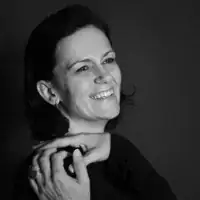 Antoine de VilliersAntoine de Villiers is an Artist and the Founder of Antoine Art Studio LLC based in Savannah, GA. Antoine has over 25 years of experience, specializing in oil painting, graphite & charcoal drawing. She has had over 70 exhibitions around the globe and her work has received numerous awards including Best Figurative Artist by The Richmond Art Museum, Indiana (USA), Best Solo Artist by Eric Smith at the New York Art Expo, and first place in Figurative Painting by Pamela Jean Tinnen from Artrepreneur. She earned her Web Design Diploma from Boston Business College and studied Indian Art, Visual Art, and Modern Art at the University of Oxford, Department of Continuing Education.
Antoine de VilliersAntoine de Villiers is an Artist and the Founder of Antoine Art Studio LLC based in Savannah, GA. Antoine has over 25 years of experience, specializing in oil painting, graphite & charcoal drawing. She has had over 70 exhibitions around the globe and her work has received numerous awards including Best Figurative Artist by The Richmond Art Museum, Indiana (USA), Best Solo Artist by Eric Smith at the New York Art Expo, and first place in Figurative Painting by Pamela Jean Tinnen from Artrepreneur. She earned her Web Design Diploma from Boston Business College and studied Indian Art, Visual Art, and Modern Art at the University of Oxford, Department of Continuing Education.
Artist You could try using your palette knife to carve lines in wet paint by putting the edge in the wet paint at a 90 degree angle to the surface and pulling it through the wet paint in the direction of the handle. Placing the blade flat on the wet paint and tapping it will create texture.
You could try using your palette knife to carve lines in wet paint by putting the edge in the wet paint at a 90 degree angle to the surface and pulling it through the wet paint in the direction of the handle. Placing the blade flat on the wet paint and tapping it will create texture.
Things You'll Need
- Palette or painting knife
- Acrylic paints or oil paints
- Paint palette
- Gessoed canvas board or wood panel
- Cloth or paper towel
References
- ↑ https://www.artistsnetwork.com/art-mediums/oil-painting/painting-knife-techniques/
- ↑ https://www.artistsnetwork.com/art-mediums/oil-painting/painting-knife-techniques/
- ↑ http://helloartsy.com/palette-knife/
- ↑ https://www.artistsnetwork.com/art-mediums/oil-painting/painting-knife-techniques/
- ↑ https://www.artsy.net/article/artsy-editorial-5-oil-painting-tips-beginners
- ↑ http://helloartsy.com/palette-knife/
- ↑ https://www.artistsnetwork.com/art-mediums/oil-painting/painting-knife-techniques/
- ↑ https://www.artistsnetwork.com/art-mediums/oil-painting/painting-knife-techniques/
- ↑ https://www.finearttips.com/2014/05/palette-knife-painting-tips/
- ↑ https://drawpaintacademy.com/palette-knife-painting/
- ↑ http://helloartsy.com/palette-knife/
- ↑ https://www.finearttips.com/2014/05/palette-knife-painting-tips/
- ↑ https://www.artistsnetwork.com/art-mediums/oil-painting/painting-knife-techniques/
- ↑ https://www.artistsnetwork.com/art-mediums/oil-painting/painting-knife-techniques/
- ↑ https://drawpaintacademy.com/palette-knife-painting/
- ↑ https://www.artistsnetwork.com/art-mediums/oil-painting/painting-knife-techniques/
- ↑ https://drawpaintacademy.com/palette-knife-painting/
- ↑ https://drawpaintacademy.com/palette-knife-painting/
- ↑ https://www.artistsnetwork.com/art-mediums/oil-painting/painting-knife-techniques/
- ↑ https://drawpaintacademy.com/palette-knife-painting/
- ↑ https://drawpaintacademy.com/palette-knife-painting/
- ↑ https://www.artistsnetwork.com/art-mediums/oil-painting/painting-knife-techniques/
- ↑ https://www.artistsnetwork.com/art-mediums/oil-painting/painting-knife-techniques/
- ↑ https://www.finearttips.com/2014/05/palette-knife-painting-tips/

